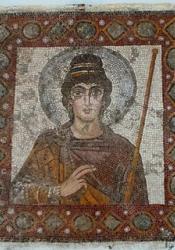Ladies of Carthage (9th Century BC)
At the end of Chapter 20, Mr. Rochester is speaking to Jane about his bride-to-be, Blanche. Mr. Rochester brags that Blanche is “[a] strapper—a real strapper, Jane: big, brown, and buxom; with hair just such as the ladies of Carthage must have had” (Bontë ch. 20). This is significant because Mr. Rochester is reflecting on Blanche’s looks, comparing her to women of a distant land, Carthage. Located in present-day Tunisia, Carthage was inhabited by Phoenician (Punic) merchants who traded throughout the Mediterranean (Docter et al. 11). The legend of the city’s founding derives from that of the Lebanese Phoenician ruler, Elissa (Dido), who journeyed with her followers from Cyprus while under political duress (Docter et al. 11). The attached image is a depiction of a Phoenician woman, possibly resembling Dido. Carthage was a prosperous nation for centuries until its demise in 146 BC at the conclusion of the Third Punic War (Docter et al. 12).
Connecting back to the text, it is significant that Mr. Rochester compares Blanche to a woman of Carthage because she is described as having a darker complexion. Women of a darker complexion often have natural hair that is deeply pigmented and/or curly. It is not known exactly what present-day race classification the Phoenician’s fall under. However, it is thought that they were a variety of people from “ancient Near East,” including those of Middle Eastern and northern African descent (Gill). Given this information, Brontë provides a breadcrumb for the reader to consider regarding the race of the upper crust society at the time. As discussed in class, the stereotype for 19th century wealth is that of the white aristocrat. Brontë is disrupting this stereotype with characters like Blanche who do not fit the “lily-white” bill, introducing the notion that the wealthy might have been different races entirely.
Docter, Roald, et al. “Carthage. Fact and Myth: Fact and Myth.” Sidestone Press, 2015. pascal-ccu.primo.exlibrisgroup.com/permalink/01PASCAL_CCU/177fn98/cdi_askewsholts_vlebooks_9789088903526, Accessed 13 Jun. 2022.
Gill, N.S. “Was Hannibal, Enemy of Ancient Rome, Black?” ThoughtCo. 2019, www.thoughtco.com/was-hannibal-black-118902#:~:text=The%20Carthaginians%20were%20Phoenicians%2C%20which%20means%20that%20they,and%20Hebrews%29%2C%20which%20included%20parts%20of%20northern%20Africa., Accessed 13 Jun. 2022.

